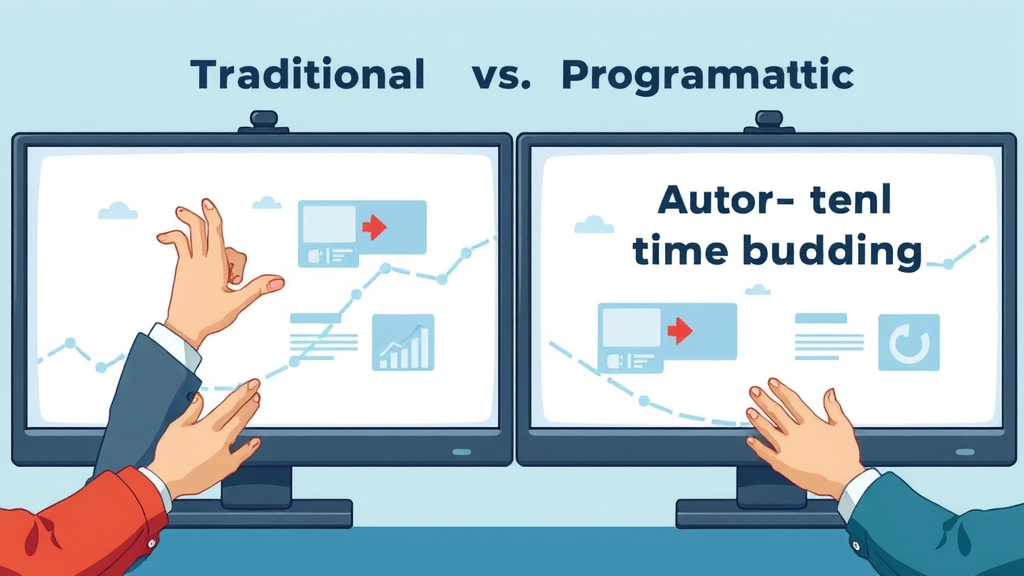Curious how the world’s top brands transform digital success overnight? What if you could reach your perfect audience, maximise every ad pound, and leave traditional ad buying in the dust—all automatically? Dive into the magic of display ads programmatic marketing and uncover how this modern strategy is reshaping display advertising for unbeatable results.

Curious How Display Ads Programmatic Marketing is Transforming Display Advertising and Digital Ad Strategy?
Display ads programmatic marketing has shifted the digital ad landscape like never before. Unlike traditional manual ad buying, programmatic ad technology uses automation and data-driven decision-making to deliver the right message to the right user at precisely the right time. Brands now have the power to scale campaigns quickly, drive display advertising performance, and outsmart the competition with unprecedented efficiency. By leveraging programmatic display strategies, you can access vast ad networks, pinpoint your target audience , and optimise your digital ads spend with measurable impact.
This new era of programmatic display advertising means your campaigns adapt in real-time, responding to user behaviours across thousands of websites, apps, and channels. Businesses no longer guess where to place ads—they rely on sophisticated algorithms to bid for the best ad space and achieve maximum ROI. Let’s explore what makes programmatic and display advertising the secret weapon of future-focused digital marketers.
Discover What You'll Learn About Display Ads Programmatic Marketing
- Understand the fundamentals of display ads programmatic marketing
- Explore key concepts like programmatic ad, ad exchanges, and display network
- Dive into the major benefits and use cases in modern media buying
- Master the hottest trends in programmatic display advertising
- Gain expert insight into optimizing your programmatic display ad strategy
Defining Display Ads Programmatic Marketing: The Core of Modern Display Advertising
At its heart, display ads programmatic marketing refers to the automated process of purchasing, placing, and optimising display ad inventory across the digital ecosystem. While traditional digital advertising often involved time-consuming negotiations and flat-rate deals, programmatic platforms now provide a seamless route to buy and sell ad space in real-time. This allows brands and agencies to reach their specific audience with unmatched precision and control, eliminating wasteful ad spend and manual drudgery.
The process leverages advanced data analytics, machine learning, and artificial intelligence, ensuring that every penny of media buying works harder for your business objectives. Programmatic display ad strategies span everything from high-traffic banner ad placements to immersive video ad experiences, all delivered with efficiency across vast display networks and ad exchanges . As digital advertising platforms continue to evolve, mastering programmatic methods becomes a core skill for any modern marketer.
What Makes Display Ads Programmatic Marketing Different from Traditional Display Ad Buying?
In the past, advertisers and publishers relied on deals arranged manually through sales teams, insertion orders, and fixed campaign schedules. This method lacked flexibility, swift reaction to trends, and often involved substantial human error. With display ads programmatic marketing , data flows seamlessly between automated systems known as demand and supply side platforms. These smart tools allow instant purchasing decisions based on live user information, context, and the performance of similar ads, driving up digital ad efficiency and engagement.
Another major difference is scale. Automated bidding across hundreds or thousands of sites in a display network would be impossible by hand. Programmatic display solutions handle massive inventories and can shift campaign focus in response to real-time analytics. Marketers gain actionable insights at every step, making programmatic advertising the gold standard for agile, results-driven campaigns. The result is less wasted budget, stronger campaign relevance, and measurable growth for any business aiming to dominate the digital advertising space.

Key Features of Programmatic Display, Ad Exchanges, and Display Network
The hallmark of display ads programmatic marketing lies in its use of technology-driven platforms. A demand side platform (DSP) allows you to bid for ad inventory in real time, selecting where your creative appears based on audience data, context, and campaign goals. The supply side platform (SSP) is the publisher’s tool, helping them maximize yield by selling ad space programmatically to the highest bidder. Connecting these is the ad exchange , where buyers (advertisers) and sellers (publishers) conduct secure, automated transactions for optimal match and transparency.
Display networks like Google Display Network, and multiple ad networks aggregate thousands of publishing partners, giving marketers vast access to online ad inventory. Through sophisticated targeting and data enrichment, programmatic approaches ensure that every banner ad or video ad has the best chance to engage its intended users. These features protect your ad spend and drive ever-higher returns through continuous campaign optimisation.
“Programmatic advertising has revolutionized display ads by automating and optimizing how brands connect with their target audiences.”
How Display Ads Programmatic Marketing Works: Programmatic Ad Buying Explained
At its essence, programmatic display ad buying is about making complex decisions within milliseconds. When a user visits a site within a display network , automated technology scans available ad space and instantly holds an auction among advertisers targeting that user profile. Demand side platforms submit bids, supply side platforms supply inventory, and the ad exchange selects the perfect match for both.
This intelligent media buying process ensures your ads reach relevant users while staying in budget. The relentless automation leads to tighter audience matches, reduced manual errors, and better performance. Programmatic ad buying empowers brands to adapt instantly, making digital advertising not only smarter but vastly more profitable for everyone involved.
Step-by-Step Process of Programmatic Display Ad Buying
Let’s break down the process of display ads programmatic marketing into straightforward steps:
- Campaign Setup : Marketers set campaign objectives, budgets, and target audience parameters within a demand side platform (DSP).
- Automated Bidding : As users visit websites, an instant auction is triggered for each available ad space , with programmatic technology evaluating relevance and value.
- Ad Selection : The highest bidder on the ad exchange wins the placement, with the right ad delivered instantly.
- Analytics and Optimisation : Data on impressions, clicks, and conversions feeds back into the system for real-time campaign refinements—maximising ROI and effectiveness.
This approach revolutionises how digital advertising works by replacing guesswork with automation and insights at every stage.
Role of Demand Side Platforms (DSPs), Supply Side Platforms (SSPs), and Ad Exchanges in Programmatic Display Advertising
Demand Side Platforms (DSPs) are tools that enable advertisers to purchase ad inventory across numerous ad exchanges and networks using sophisticated targeting criteria. Supply Side Platforms (SSPs) serve publishers, aggregating ad space and maximising revenue by exposing it to more buyers. The ad exchange acts as an open marketplace where these transactions happen, ensuring competitive pricing and transparency.
Each platform in the ecosystem supports precise matching of display ad opportunities to advertisers’ campaign needs, powered by high-speed automation and continuous data analysis. This allows businesses to stay agile, freeing marketers from repetitive tasks while delivering better results at scale.
| Platform | Function in Programmatic Display | Example |
|---|---|---|
| Demand Side Platform | Buys ad inventory | The Trade Desk |
| Supply Side Platform | Sells ad inventory | Google Ad Manager |
| Ad Exchange | Matches buyers and sellers | OpenX |
| Display Network | Delivers display ads to users | Google Display Network |

Advantages of Display Ads Programmatic Marketing for Businesses
Embracing display ads programmatic marketing means transforming how your business connects with digital audiences. Programmatic advertising leverages data-driven targeting , meaning campaigns tap into audience segments built on real behaviour and context. As a result, campaigns achieve higher relevance, improved efficiency, and stronger ROI compared to traditional display advertising approaches.
Smart programmatic display strategies constantly adapt to consumer habits, adjusting digital ad placement in real time. Whether you’re running a banner ad, interactive content, or a video ad, programmatic platforms use analytics to optimise performance automatically. This ensures every pound of media spend is tracked, measured, and refined for success, freeing businesses to focus on strategic growth.
Data-Driven Targeting and Real-Time Optimization in Digital Advertising
One of the most compelling advantages of programmatic advertising is its ability to harness vast amounts of data—everything from demographics and interests to device usage and browsing habits. This wealth of information enables hyper-targeted campaigns, ensuring financial resources are invested only in inventory that delivers the best value and engagement.
In digital advertising, real-time optimisation means your display ads campaign adjusts every moment it runs. If a particular creative isn’t performing, algorithms shift focus automatically towards versions with higher conversion rates. These ongoing refinements are nearly impossible in traditional display advertising, but in the world of programmatic ads, they’re standard practice.
Cost Efficiency and Increased ROI in Display Advertising Campaigns
Cost efficiency is vital for any marketing team, especially when ad spend must deliver maximum returns. With display ads programmatic marketing , campaigns operate under strict budget controls, only bidding for inventory that meets specific performance goals. Programmatic platforms continuously measure impressions, clicks, and conversions, reallocating ad spend in real time for peak ROI.
This precision eliminates much of the waste associated with traditional digital advertising, ensuring brands extract more value from every pound spent. As programmatic display becomes the standard, businesses investing early can enjoy substantial performance gains, leapfrogging rivals constrained by outdated campaign tactics.

Enhanced Reach with Programmatic Display Advertising and Global Display Networks
Programmatic and display ad strategies break down the barriers to global reach. Connecting to multiple display networks and international ad exchanges empowers brands to extend campaigns beyond domestic audiences. Whether your goal is local impact or worldwide exposure, programmatic advertising ensures the right users see your message—wherever they may be online.
This greatly increases potential market size without adding complexity. Automated systems translate campaign requirements into actionable audience segments across diverse regions, languages, and platforms, making global digital advertising as straightforward as a local campaign.
“Brands leveraging programmatic display advertising typically see a 30% increase in ROI due to smarter targeting.”
Key Types of Display Ads and Creative Formats in Programmatic Ads
Modern display ads programmatic marketing supports a variety of ad formats suited for every campaign objective. Banner ads remain a popular staple, offering high-visibility solutions across web, app, and social environments. Interactive formats, including rich media and custom video ads, drive deeper engagement with target audience segments through compelling storytelling and user interaction.
Native ads blend seamlessly into host environments, maintaining natural user experiences while achieving high click-through rates. These formats are accessible across leading display networks and ad exchanges , supported by intelligent bidding for optimal ad placement .
Banner Ads, Video Ads, Native Ads, and Rich Media in Display Network Ecosystems
- Banner Display Ads
- Interactive Programmatic Ad Formats
- In-stream Video Display Advertising
- Native Display Ads in Programmatic & Ad Exchanges
Choosing the right format for your campaign involves balancing creative aspirations, audience preferences, and platforms used. Interactive programmatic ads are ideal for complex storytelling, while banners deliver awareness at scale, and native slots build brand trust in context-rich environments.

The Role of Ad Exchanges and Ad Networks in Programmatic Display Ad Media Buying
Ad exchanges and ad networks play a central role in media buying for programmatic campaigns. Ad exchanges function as digital marketplaces, matching supply (publishers' ad inventory) with demand (advertisers seeking impressions), efficiently connecting both through real-time technology. This streamlines the process for all parties, fostering competition and ensuring the highest-value ad space finds the right advertisers swiftly.
Ad networks aggregate inventory from thousands of publishers, categorising inventory so advertisers can buy relevant placements with ease. Together with exchanges, they power the vast reach and efficiency of display ads programmatic marketing , future-proofing digital campaigns in a fiercely competitive arena.
How Ad Exchanges Operate in the Display Ads Programmatic Marketing Landscape
Programmatic ad exchanges use advanced algorithms and data integrations to execute millions of real-time auctions daily. Each auction matches user data, publisher criteria, and advertiser intent, selecting the perfect creative for every user view. This process increases competitiveness, improves campaign transparency, and minimises waste in media buying.
Marketers can access extensive reporting and controls within many leading ad exchanges, allowing granular management over ad spend , targeting, and creative testing—all crucial facets of a successful programmatic display ad strategy.
Choosing the Right Display Ad Network and Digital Advertising Platforms
Selecting the right display network and ad exchange depends on your goals, audience, and available creative assets. Look for platforms with robust audience segmentation, advanced fraud prevention, and cross-device capabilities. Assess potential inventory quality, geographic reach, and the data integrations that facilitate sharp personalisation and timely optimisation of your display advertising .
Platforms like Google Display Network, OpenX, and specialty ad exchanges offer unique value propositions. Partnering with experienced programmatic teams or platforms ensures the best fit for your budget and objectives, maximising returns from every campaign run through programmatic and display solutions.
Key Strategies to Optimize Your Display Ads Programmatic Marketing Campaigns
Taking your display ads programmatic marketing efforts to the next level requires strategic focus. With endless competition for user attention, custom-tailored approaches and continuous optimisation are vital. Smart marketers leverage audience segmentation, rigorous data analysis, and creative agility to deliver standout campaigns with unbeatable performance.
Honing these strategies boosts every metric—from click-through rates to conversions—and positions your brand for standout digital advertising success in any market segment.
Audience Segmentation and Personalization for Advanced Programmatic Advertising
Audience segmentation is central to programmatic success. By dividing markets into precise groups—based on demographics, interests, or online behaviour—brands craft personalised messages for each group. Programmatic tools track user journeys and adjust ad creative in real time for higher relevance and engagement with every impression.
This approach transforms “one-size-fits-all” ads into personalized journeys. Customisation often yields higher ROI, deeper retention, and a positive perception of your brand. Modern side platforms and display networks make context-aware advertising the new industry standard, ensuring every campaign speaks directly to its intended audience.

Utilizing Data, Analytics, and A/B Testing in Display Advertising
Robust data and analytics underpin every successful display ads programmatic marketing campaign. Machine learning algorithms detect patterns in vast data streams—pinpointing which creatives, placements, and audience segments yield the best results. A/B testing enables marketers to compare variations, ensuring campaigns steadily improve through actionable insights.
Regular reviews of click, conversion, and viewability rates help teams optimise spend for the highest return. Programmatic platforms automate many of these processes, ensuring decisions are always made based on the freshest data, keeping your digital advertising ahead of the curve.
Tips for Maximizing Creative Performance in Programmatic Display Ads
- Set clear campaign goals for your programmatic and display ads
- Leverage machine learning for intelligent ad placement
- Regularly update and test ad creatives
- Use real-time reporting for optimization
- Integrate audience data with programmatic ad platforms
Creative iteration is just as crucial as targeting. Compelling, well-designed display ads capture attention and motivate action. Winners blend strong visuals, direct CTAs, and persuasive offer messaging—constantly refined for top performance with every campaign cycle.
Managing and Measuring Success in Display Ads Programmatic Marketing
Rigorous measurement is essential for sustainable growth in display ads programmatic marketing . Marketers must track every key metric—from impression volume to conversion events—using robust dashboards provided by programmatic platforms. Continuous monitoring enables real-time budget adjustments and rapid creative optimisation, fuelling ongoing performance improvements across digital campaigns.
This level of precision transforms every campaign into a learning opportunity, enabling brands to build smarter, more efficient strategies over time. With the right tools in place, your programmatic display efforts will drive consistent growth without wasted ad spend.
Analyzing Metrics: Impressions, Clicks, Conversions, and Beyond in Programmatic Display Campaigns
Metrics act as the compass for your programmatic advertising journey. Impressions reveal campaign reach, while click-through rate (CTR) gauges creative effectiveness. Conversion rate is the ultimate measure of direct ROI, linking ad engagement to desired business actions. Cost per thousand impressions (CPM) and cost per click (CPC) shed light on budget efficiency.
Viewability rates ensure your ads are actually seen—not just served—boosting the overall quality of your display ad efforts. Understanding these metrics empowers you to tweak, test, and triumph with each subsequent campaign.
| Metric | Programmatic Display Value |
|---|---|
| Impressions | Volume/Growth |
| Click-Through Rate | Campaign Relevance |
| Conversion Rate | Direct ROI Measure |
| CPM / CPC | Budget Efficiency |
| Viewability Rate | Ad Quality |

Adjusting Budget Allocations Across Ad Exchanges and Display Network
Dynamic budget allocation ensures ad spend is always aligned with the highest-performing strategies. Programmatic technology automates reallocation—shifting investment from underperforming channels or creatives to those delivering maximum impact. By monitoring performance across multiple ad exchanges and display networks, your campaigns remain agile and cost-effective at every stage.
Smart adjustments based on data prevent overspending on low-engagement placements and guarantee sustainable growth, setting the foundation for long-term digital advertising success.
Common Challenges in Display Ads Programmatic Marketing and How to Overcome Them
Despite its many advantages, display ads programmatic marketing presents challenges that marketers must address proactively. Key pain points often include brand safety, ad fraud, viewability issues, data privacy, and managing campaign complexity across diverse platforms and ad networks. Recognising and fixing these obstacles is essential for maximising benefits while minimising risk and waste in your programmatic strategy.
Proactive solutions—like robust monitoring tools, careful partner selection, and compliance checks—enable marketers to stay ahead of threats and maintain high campaign standards across all digital ad activity.
Solving Brand Safety, Ad Fraud & Viewability Issues in Programmatic Display Advertising
Brand safety is top of mind in programmatic display. With thousands of sites in each ad network , ensuring your ads avoid inappropriate or risky content is crucial. Leading platforms offer pre-bid filters, blocklists, and context-driven safety checks to protect your investment. Sophisticated fraud detection algorithms identify invalid traffic, fake views, and artificially inflated metrics—shielding your campaigns from wasteful spend and reporting errors.
Viewability tools ensure your display ads are displayed in optimal locations and formats that real users see, not hidden at the bottom of pages or on non-human traffic sites. This assertion of quality directly correlates with better campaign results and higher return on investment.
Managing Complexity Across Multiple Programmatic Ad Platforms and Ad Networks
As campaign reach expands, so does the technical complexity of running across multiple platforms. Dealing with different reporting standards, optimisation tools, and creative requirements can overwhelm even experienced marketers. Solutions such as consolidated dashboards, unified analytics, and dedicated programmatic agencies help manage and harmonise campaign operations.
Choosing integrated platforms and partners with proven cross-channel expertise smooths the process, enabling higher efficiency and streamlined media buying for every digital campaign.
Ensuring Compliance and Privacy in Display Advertising Media Buying
Data protection regulations, like the UK’s GDPR, make privacy critical in display ads programmatic marketing . Marketers must obtain valid consent, manage user data responsibly, and enforce best practices across all campaign touchpoints. Robust compliance tools, transparent reporting, and regular audits ensure your programmatic operations stay on the right side of regulations—protecting both brand reputation and customer trust.
Every reputable display network , ad exchange, and platform now provides features to help track and manage privacy compliance, keeping your campaigns safe for both users and industry scrutiny.

Emerging Trends in Programmatic Display and Digital Advertising
Display ads programmatic marketing continues to evolve at a lightning pace. Artificial intelligence, machine learning, and automation now power smarter ad targeting, faster optimisation, and even predictive creative updates—enabling brands to stay ahead of user behaviour and market trends. Understanding what’s next is key to futureproofing your marketing efforts.
As ad technology grows more sophisticated, expect deeper personalisation, smarter audience segmentation, and new creative formats built for tomorrow’s consumer demands. Staying on top of these trends means your digital advertising strategies maintain maximum impact and relevance.
AI, Machine Learning & Automation in Display Ads Programmatic Marketing
The rise of AI and automation is transforming programmatic display ad delivery. Machine learning models analyse audience signals, purchase behaviour, and prior campaign outcomes, guiding bid strategies and creative selection far faster and more accurately than humans alone ever could. As algorithms grow smarter, campaigns can even predict when and where individual users are likely to convert—directing budgets for optimal effect.
This rapid advancement enhances every stage of the marketing funnel, from prospecting to retargeting, while steadily improving ROI over time for all types of digital ad campaigns.
The Impact of Video, Mobile, and Connected TV in Programmatic Display Ad Growth
With mobile and streaming usage at all-time highs, programmatic video, mobile, and connected TV (CTV) advertising are essential growth channels. Brands that master video ad placements and in-app targeting enjoy higher engagement and brand recall compared to static banners alone. Programmatic technology ensures campaigns reach the right screen at the right moment, integrating seamlessly into today’s omnichannel consumer journeys.
By staying agile and prioritising these emerging platforms, you maintain a competitive edge in the digital advertising marketplace—while reaching audiences wherever their attention lives.
People Also Ask: What are programmatic display ads?
Programmatic display ads are automated, data-driven advertisements delivered across digital platforms using programmatic technology, including display ad networks and ad exchanges, optimizing targeting in real-time.
People Also Ask: What are display ads in marketing?
Display ads in marketing are visual advertisements (banners, images, or videos) shown across digital platforms to promote products or services, often enabled by programmatic display marketing.
People Also Ask: What is the programmatic method of selling display advertising?
The programmatic method of selling display advertising involves automated real-time bidding through ad exchanges, matching ads with audiences via demand and supply platforms for more efficient digital advertising.
People Also Ask: What are the 4 types of programmatic deals?
The four types of programmatic deals are: open auction (real-time bidding across multiple inventory sources), private marketplace (invitation-only bidding), preferred deal (fixed CPM price pre-negotiated), and programmatic guaranteed (reserved inventory, fixed price).
Frequently Asked Questions About Display Ads Programmatic Marketing
-
How does display ads programmatic marketing increase ROI?
By leveraging data to target specific audience segments and adjusting spend in real time, programmatic marketing minimises waste and delivers higher engagement, directly boosting campaign ROI. -
What platforms support programmatic display ad buying?
Leading platforms include The Trade Desk, Google Display Network, OpenX, and Google Ad Manager, among others, each offering unique features for advertisers and publishers. -
Is programmatic advertising suitable for all industries?
Yes. Any sector wanting scalable, data-driven digital reach can use programmatic display, from retail and travel to finance and B2B. -
Can I control targeting and frequency in programmatic display campaigns?
Absolutely. Marketers have granular control over audience filters, ad scheduling, and how often users see each creative—maximising relevance and minimising user fatigue. -
How do I get started with display ads programmatic marketing?
Begin by identifying campaign goals, selecting a trusted programmatic ad platform, and partnering with digital marketing experts to tailor audience and creative strategies for best results.
Transform Your Digital Advertising Game with Display Ads Programmatic Marketing
Contact https://www.capidhouser.com/ today to discuss your digital marketing London business needs and unlock the power of display ads programmatic marketing.
Start now: Harness programmatic display ad marketing to outsmart your competition, delight your target audience, and amplify your ROI.
To deepen your understanding of display ads programmatic marketing, consider exploring the following resources:
-
“Programmatic Display Advertising 101: The Secret to Higher Conversions” : This article provides a comprehensive overview of programmatic display advertising, detailing its types, benefits, and strategies to enhance conversion rates. ( adpushup.com )
-
“Programmatic Vs Display Network Advertising: What’s the Difference?” : This piece elucidates the distinctions between programmatic and display network advertising, helping marketers choose the most effective approach for their campaigns. ( outbrain.com )
If you’re serious about mastering display ads programmatic marketing, these resources will provide valuable insights and practical strategies to elevate your digital advertising efforts.
 Add Row
Add Row  Add
Add 




Write A Comment